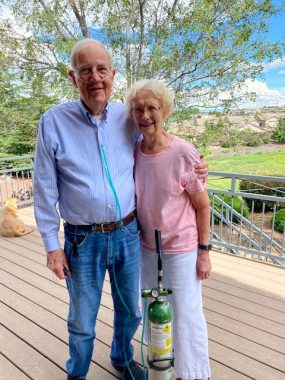What Do a Jet Fighter and a PAH Fighter Have in Common?
Columnist Colleen Steele shares one pilot's incredible story

Answer: resilience.

Randolph Reynolds is geared up and ready to fly an F-105 in 1978. (Courtesy of Randolph Reynolds)
Randolph Reynolds, 81, had an amazing career as a jet fighter and instructor pilot in the United States Air Force, flying magnificent aircraft like the F-105 Thunderchief and F-4D Phantom and building an impressive résumé with NASA. From there, he spent another 10 years teaching aerodynamics as a faculty member and associate dean at the Prescott, Arizona, campus of Embry-Riddle Aeronautical University.
I can only imagine that when Randolph was diagnosed with pulmonary arterial hypertension (PAH) five years after retirement, it must have felt like a crash landing.
Before his PAH diagnosis in December 2014, Randolph took on an ambassador position at a local hospital. This meant visiting patients and spending a few minutes letting them know they hadn’t been forgotten by the outside world. He also fought and won a battle with prostate cancer and struggled with depression, learning how to better manage it.
As testimony to his resilience, eight years ago, his PAH diagnosis came with the prediction that he had only two years to live. Randolph’s response to being tethered to an oxygen tank? He took flight again by writing. Since then, he’s published six books. His most recent was “Milliscent And Me: Living With PAH, a Terminal Disease.”
Surprisingly, Milliscent is not Randolph’s wife. She’s his significant other, which he describes in his book as being 26 inches tall and about 5 inches in diameter.

Randolph and Vonna Reynolds and Milliscent, center, enjoy a summer day on Aug. 18. (Courtesy of Randolph Reynolds)
The real Mrs. Reynolds, Vonna, 83, aptly named Randolph’s oxygen tank Milliscent, a name derived from Germanic words meaning “work” and “strong.”
In Randolph’s book, he shares many stages of his life, not just his PAH journey. I found this approach refreshing because it’s a reminder that who we are is not based on only our current circumstances.
It reminds me of a quote from John Banville’s novel “The Sea”: “The past beats inside me like a second heart.”
And if our circumstances happen to be living with PAH, it’s important to remember that the world continues to turn and that PAH is not the only thing affecting us. There are also spirituality, societal changes, and politics. Sometimes even a pandemic comes along to shake things up.
You might not share the same experiences and opinions as Randolph, but you can appreciate the honesty with which he writes about how “living” affects his PAH as much as PAH affects his life.
Symptoms, diagnosis, and treatments
Around 2010, Randolph started experiencing some concerning episodes and symptoms. He frequently stopped breathing during the night, which would jerk him awake. When a sleep study recorded 20 episodes like this, his doctor placed him on a continuous positive airway pressure machine, or CPAP.
In 2012, shortness of breath with exertion became an issue, and one day he collapsed while walking up a steep incline. A bit of a shock for someone who had been an active jogger! This episode led to a ventilation/perfusion scan, which examines air and blood flow in the lungs. An embolism was found, and he was placed on the blood thinner Coumadin (warfarin).
Two years later, Randolph’s cardiologist had concerns about a previous stress test and ordered an angiogram. The results showed a severe type of PAH called chronic thromboembolic pulmonary hypertension, or CTEPH, which is caused by blood clots that don’t dissolve in the lungs.
Randolph’s doctor placed him on the PAH treatment Adempas (riociguat).
Traveling to the next treatment
PAH did not stop Randolph and Vonna from continuing to pursue their love of traveling.
Randolph devotes a chapter to this and shares how he packed his CPAP and medications and purchased a portable concentrator for his trips.
From the way he describes them, the vacations were breathtaking, but PAH was also taking Randolph’s breath away. He collapsed several times while traveling and after returning home.
He went through more testing and started a new treatment, Remodulin (treprostinil). He named the infusion pump the “black box.”
Year of the Rabbit
Via email, I asked Randolph to share a little about his relationship with Vonna. He explained that they met in Japan. A nickname started when they learned that Vonna was born in the Year of the Rabbit, and “Rabbit” is how he fondly refers to her in his book.
They’ve been married for 55 years and live in Prescott.
“We have been close partners since we met and have helped each other out,” Randolph said. “When I began to deal with PAH she had to add my peculiar needs to her workload. At her age, she deserves to be free from many of the household duties that she does. I contribute little to that. She is marvelous and keeps everything positive.”
I invite you to join the Pulmonary Hypertension News Forums and discuss Randolph’s book with him and other members.
Note: Pulmonary Hypertension News is strictly a news and information website about the disease. It does not provide medical advice, diagnosis, or treatment. This content is not intended to be a substitute for professional medical advice, diagnosis, or treatment. Always seek the advice of your physician or other qualified health provider with any questions you may have regarding a medical condition. Never disregard professional medical advice or delay in seeking it because of something you have read on this website. The opinions expressed in this column are not those of Pulmonary Hypertension News or its parent company, Bionews, and are intended to spark discussion about issues pertaining to pulmonary hypertension.









Donna House
Thanks for your interesting article on Randolph Reynolds and his fight with CTEPH. A caregiver is usually your mate who helps you through the rough patches and is with you every day. My husband Byron and I have been married for 49 yrs in 2023 and I was diagnosed with PAH first and finally CTEPH. I have often wondered if I am still living what the next option after Adempas would be for me. I too would like to make people more aware of CTEPH.
Colleen Steele
Thank you Donna, for reading about Randolph's journey and expressing an interest in sharing your own. I actually have an opportunity for you to do that.
"30 Days of PH": In November, we will feature the story of a person close to PH. This could be a patient or family member, partner or friend of someone with PH. Our goal is to have a collection of different approaches to different facets of life with PH that could (hopefully) connect and empower our readers.
I would love for you to share your CTEPH experience. For more information please email me at [email protected]
Randy Reynolds
Thanks Donna
Perhaps your management of PAH / CTEPH will go as smoothly as mine has. I am about to reach the eight year point since my diagnosis.
Randy
Colleen Steele
Thank you, Randy for sharing your PH journey with us. I've no doubt your words have helped others feel less alone.